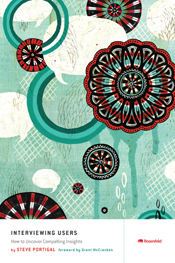In some cases, I would spend some time lending a little more substance to some of my anecdotal examples. For instance, I have long been talking about how people open up just as you’re wrapping up an interview with them. Someone compared it to what happens in psychotherapy. This prompted me to do a little bit of desk research, and I found a term for that. It’s called the door-knob phenomenon, and it’s well known in the medical field, as well as in psychiatry. I think this kind of small enlightenment—realizing, oh, that has a name—helped me to tighten things up and tell the story a little better in the book.
What happened, too, was that the coalescing that occurred during the writing process found its way back into the workshops or other work that I’m doing, forming a really nice feedback loop.
Jeff: In your book, you do a great job of addressing the use of research as a leadership activity within an organization. But the situation seems more challenging when you are working as an outside design consultant, who a client has hired to work on a clearly defined project, and you have limited clout, visibility, and understanding of where push-back to doing user research may lie within a company. In such a situation, how would you illustrate the value of research and get it brought into the scope of the project?
 Steve: I’ve worked as a consultant for so much of my career, and people often ask me the opposite question, “So, how does what you’re talking about as a consultant apply to me when I’m in house?” I’ve actually been trying to develop that perspective over the last couple of years, and I think you’re right, that’s in the book.
Steve: I’ve worked as a consultant for so much of my career, and people often ask me the opposite question, “So, how does what you’re talking about as a consultant apply to me when I’m in house?” I’ve actually been trying to develop that perspective over the last couple of years, and I think you’re right, that’s in the book.
I’ve got a presentation on SlideShare called “Championing Contextual Research in Your Organization”![]() that considers some of those ideas and takes a look at getting buy-in. But you’re right, the consulting case is very different. It’s more about being an effective consultant than doing the research. I didn't want the book to get into that because the consulting business is already well covered, but I appreciate your question.
that considers some of those ideas and takes a look at getting buy-in. But you’re right, the consulting case is very different. It’s more about being an effective consultant than doing the research. I didn't want the book to get into that because the consulting business is already well covered, but I appreciate your question.
I think—and this reflects my bias—for all the work that I do for clients, we’ve agreed up front that we’re going to do some kind of research-informed design process. It’s really about how I, as a consultant, sell my services. There’s a discussion that happens before the work commences about what I’m going to do. It’s good for design consultants to be very clear about the process they’re advocating. If there isn’t buy-in before a project starts, maybe that project isn’t a good fit. You shouldn’t marry someone expecting that he or she is going to change once you build a life together, and I don’t think you should take a consulting project thinking that you’re going to change the approach once you start working with a client. To be successful, consultants should be doing projects that are about leveraging what they believe in, their passions, and their strengths. It’s not too terrible to say no to clients who don’t align with what you believe in, what you’re good at, and how you want to approach a project. That’s the difference between being a freelancer and being a consultant.
Jeff: I guess this question applies to both the in-house and the consulting cases: Is there such a thing as a cheap, quick, potent “gateway drug” to get people hooked on integrating research into their development process?
Steve: I love your metaphor, the “gateway drug”! Yeah, I’ve seen this happen so many times, where going out to see single users doing their thing in their own environment and talking about it is enough to make a person’s jaw drop.
I’ve seen some organizations turn this into a process, where they set up a regularly scheduled field day. Often what they’re doing is just getting people out to see customers. They’re not conducting a rigorous, consistent data-collection activity, and they’re not doing very much with the data. Instead, it’s more about setting up that gut-punch effect and learning that people do not think and talk the way you fantasize that they do.
There’s a lot of talk about how powerful video is, and I don’t disagree with that, but you’ve got to understand what its limitations are. We took a client out into the field, and they were really profoundly moved by the experience—by the people they met and seeing how they talked. They asked us to quickly put together a short video from our footage. This was midway through the project, not a final-report video where we had some findings to convey. They never told us what their goal was, exactly. Later, they called us and said, “You didn’t hit it out of the ballpark.” They were disappointed that their stakeholders didn’t watch our five-minute video and come away as touched as the team had been when they had spent hours in these people’s homes.
Of course! You can’t take an immersive, in-person experience, boil that down into five minutes of footage, then expect the video to have the same kind of impact. Maybe, if you took the first five minutes of Up, you could have that kind of impact, but that’s a Pixar level of storytelling that’s far beyond slapping together some video moments from a few days in the field. Video is powerful, but it doesn’t have the same profound effect that being there can have.
Jeff: Do you think it would be valuable for students to get this sort of field experience, seeing for themselves that people don’t always behave as they might imagine people do?
Steve: I think that would be a fantastic thing. It’s all a learning process, and one of the things that you learn by doing research is the discovery that you don’t know everything. That’s a great experience for students to have—to learn that they can learn, as opposed to their believing that they’re already supposed to know what people are about. When I’ve worked with students and taught in design programs, I don’t see any resistance to this; I see a lot of excitement about this. In a learning setting, there don’t seem to be any of the barriers to including research in the design process that might be present in production environments.
Jeff: So, while we’re talking about the next generation of designers, where do you see the role of ethnographic design research heading by the end of the decade?
 Steve Portigal, a fixture on the design research scene and founder of
Steve Portigal, a fixture on the design research scene and founder of 